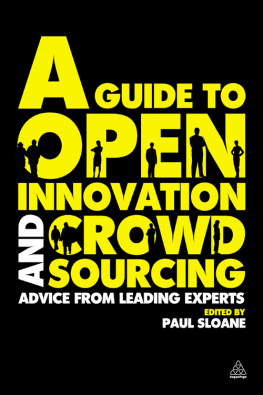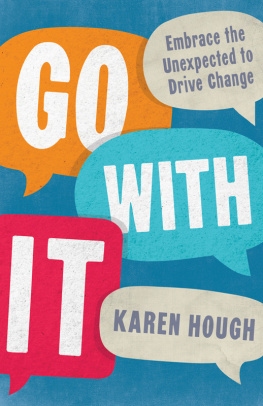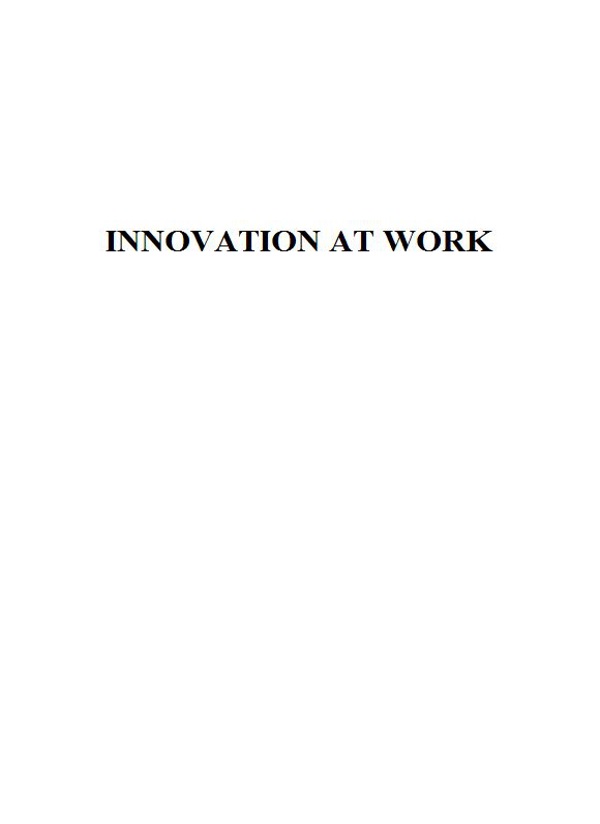Bulk discounts available. For details visit:
www.amacombooks.org/go/specialsales
Or contact special sales:
Phone: 800-250-5308
Email: specialsls@amanet.org
View all the AMACOM titles at: www.amacombooks.org
This publication is designed to provide accurate and authoritative information in regard to the subject matter covered. It is sold with the understanding that the publisher is not engaged in rendering legal, accounting, or other professional service. If legal advice or other expert assistance is required, the services of a competent professional person should be sought.
ISBN : 978-0-8144-3236-5 (eBook)
Library of Congress Cataloging-in-Publication Data
Brynteson, Richard.
Innovation at work : 55 activities to spark your teams creativity / Richard Brynteson.
p. cm.
Includes bibliographical references and index.
ISBN 978-0-8144-3234-1
1. ManagementTechnological innovations. 2. Creative ability in business. 3. Teams in the workplace. 4. Organizational change. I. Title.
HD30.2.B796 2013
658.4022dc23
2012017450
2013 by HRD Press
All rights reserved.
Published by AMACOM Books, a division of the American Management Association.
The worksheets on the pages listed here have been adapted from other sources as follows: Worksheet #4 on pg 35, A Whole New Mind, adapted from A Whole New Mind by Daniel Pink. Worksheet #11 on pg. 69, Problem Solving Methodology, is based on work by The Creative Problem Solving Institute. Worksheet #13 on pg 119, Sources of Innovation, is adapted from Innovation and Entrepreneurship by Peter Drucker. Worksheet #14 on pg 125, The Ten Faces of Innovation, is adapted from The Ten Faces of Innovation by Tom Kelley. Worksheet #22 on pg 179, Criteria for Innovations, adapted from the video Tactics of Innovation by Joel Barker.
This publication may not be reproduced, stored in a retrieval system, or transmitted in whole or in part, in any form or by any means, electronic, mechanical, photocopying, recording, or otherwise, without the prior written permission of AMACOM, a division of American Management Association, 1601 Broadway, New York, NY 10019
The scanning, uploading, or distribution of this book via the Internet or any other means without the express permission of the publisher is illegal and punishable by law. Please purchase only authorized electronic editions of this work and do not participate in or encourage piracy of copyrighted materials, electronically or otherwise. Your support of the authors rights is appreciated.
About AMA
American Management Association (www.amanet.org) is a world leader in talent development, advancing the skills of individuals to drive business success. Our mission is to support the goals of individuals and organizations through a complete range of products and services, including classroom and virtual seminars, webcasts, webinars, podcasts, conferences, corporate and government solutions, business books, and research. AMAs approach to improving performance combines experiential learninglearning through doingwith opportunities for ongoing professional growth at every step of ones career journey.
Printing number
10 9 8 7 6 5 4 3 2
Information about External Hyperlinks in this ebook
Please note that footnotes in this ebook may contain hyperlinks to external websites as part of bibliographic citations. These hyperlinks have not been activated by the publisher, who cannot verify the accuracy of these links beyond the date of publication.
Contents
PDF files for the Worksheets are available to purchasers of the book at: www.amacombooks.org/go/InnovationWork
As the economy dramatically shifts and settles, fundamental questions are being raised about the readiness of the workers to handle the jobs of the future. Is your company ready to handle international competition? Is it agile enough to deal with rapid change? What skills will the new economy require?
Traditional education with a focus on a proficiency in reading, writing, and arithmetic has worked in the past, but the new workplace requires more from its employees.
Employees need to think critically, solve problems, innovate, collaborate, and communicate more effectivelyand at every level within the organization. According to an AMA Critical Skills Survey, many executives admit there is room for improvement among their employees in these skills and competencies.
In an effort to assess how top of mind these skills and competencies are, the American Management Association (AMA)in conjunction with P21, a national organization that advocates for 21st-century readiness for every studentsurveyed 2,115 managers and other executives in AMA member and customer companies about the importance of the four Cs to their organization today and in the future.
This survey defined the most critical skills for organizational success as follows:
Critical thinking and problem solvingthe ability to make decisions, solve problems, and take action as appropriate;
Effective communicationthe ability to synthesize and transmit your ideas both in written and oral formats;
Collaboration and team buildingthe ability to work effectively with others, including those from diverse groups and with opposing points of view;
Creativity and innovationthe ability to see whats NOT there and make something happen.
For more information on the findings and a copy of the survey, visit http://www.amanet.org/training/articles/3727.aspx
Purpose of This Book
The purpose of this book is to create centers of innovation. We are past the point where we can rely on brilliant or creative individuals. Innovation has to be organization-wide. Organizations have to build capacity for innovation so that they can produce innovation after innovation. This book presents ways to build that capacity. This book provides exercises and activities to build the innovation muscle of individuals, groups, and organizations.
It is my strong belief that innovation can be a learned trait by individuals, groups, and organizations. These exercises provide a roadmap, a method, an impetus to develop that trait.
How and Where to Use the Exercises
These exercises do not need to be used in any particular order. The time parameters do not need to be followed. They do not have to be followed verbatim. They can be plucked and harvested in any number of ways.
Some situations where these exercises may be used include:
For standalone play during lunch and learn sessions at your organization.
In organization-wide innovation training sessions.
Strategically placed during process redesign sessions in order to shake up the thinking of participants.
Peppered into fun events, such as scavenger hunts and company picnics.
In problem solving, when tackling organizational problems head-on.
As team-building activities for teams and groups.
As activities for friendly competition between work groups.
In all cases, these exercises will help build the organizational innovation muscle.
Innovation is necessary for survival. This statement is true for individuals as well as for organizations. In order for us to be competitive as individuals, as organizations, and indeed, as a nation, we need to constantly add more value for our clients, customers, and constituencies. We do this through innovation. The innovation journey is fraught with obstacles. Naysayers line the route with catcalls, such as










